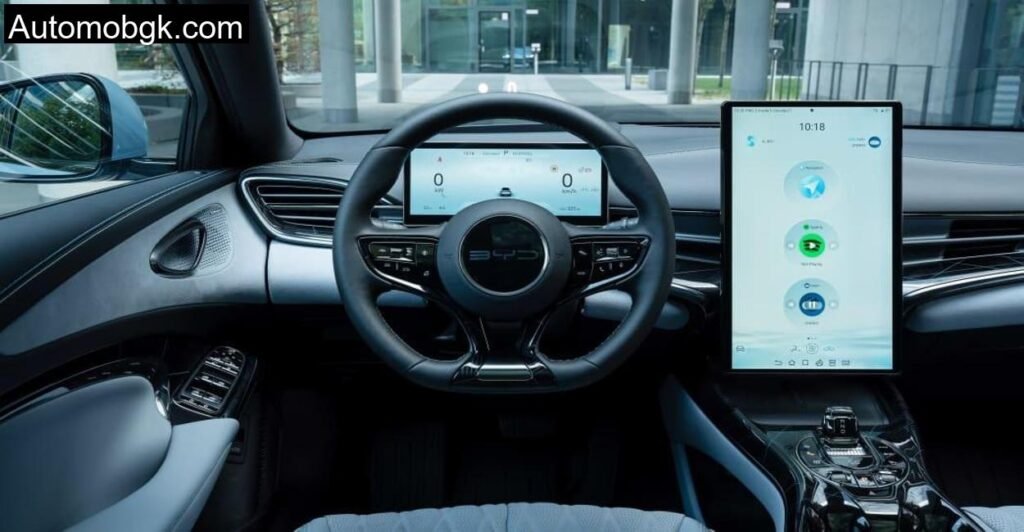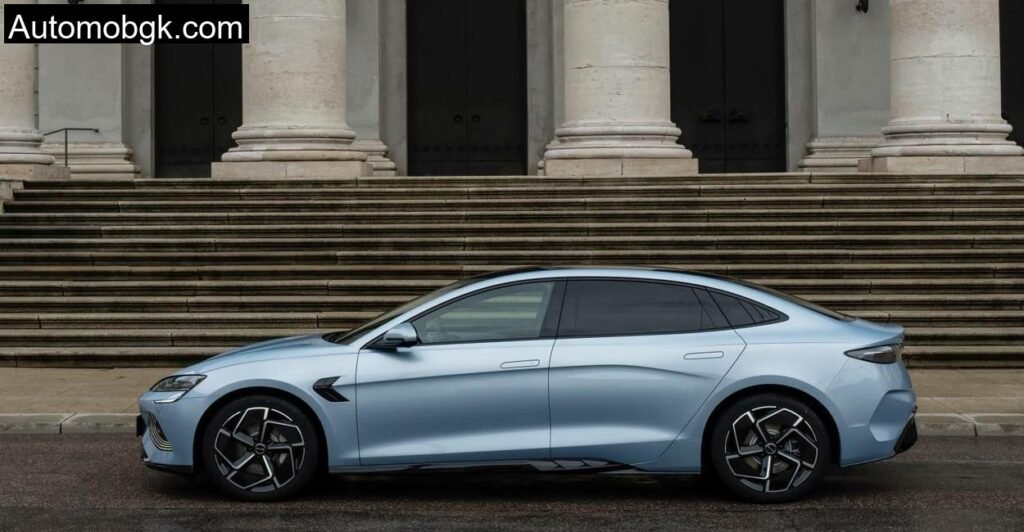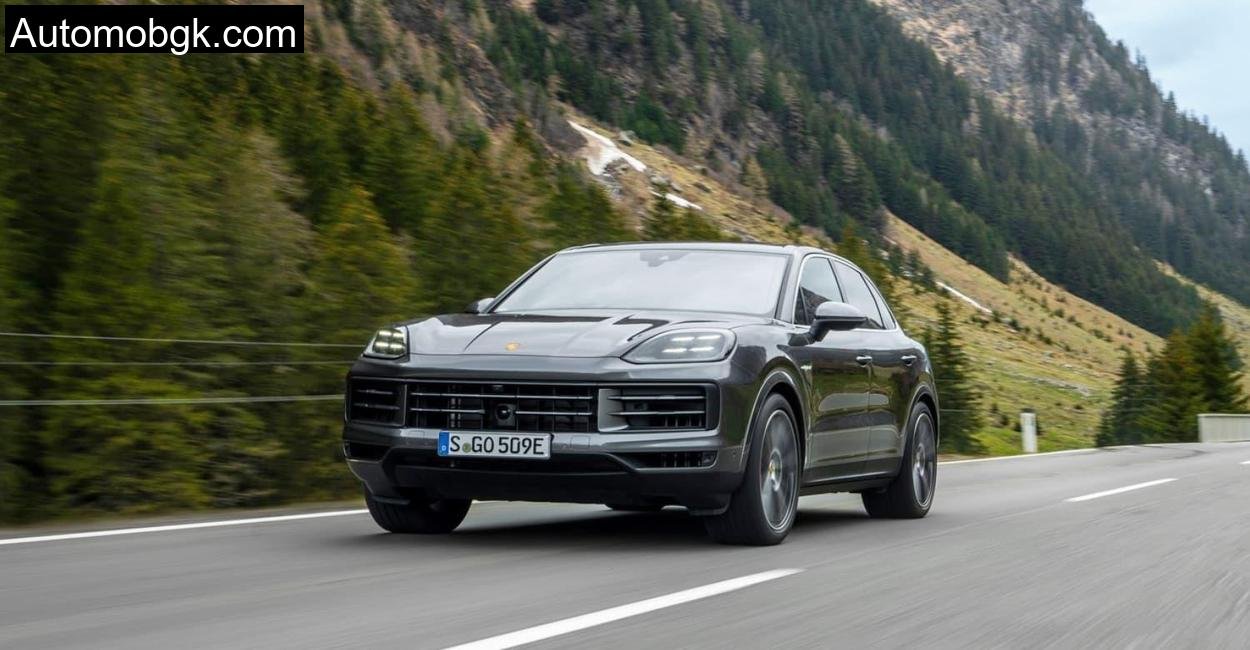This wasn’t our first electric car test in the Hütten Hills, but it was easily the most exciting. As a rider and tester, I was drawn in not just by the car’s specs, but by how it felt beneath me, how it responded to the sharp curves, and how it carried itself when the climb got steep.
BYD Seal Competes with Tesla Model 3
With its sleek, elongated 4.80-meter frame and confident stance, the BYD Seal doesn’t just enter the ring with the Tesla Model 3,it demands attention. At first glance, it draws admiration. But under the hood (and the undercarriage), the real magic lies in its powertrains: a rear-wheel-drive version with 230 kW (313 hp), and a more aggressive all-wheel-drive setup boasting 390 kW (530 hp).
These numbers aren’t vanity metrics. During our climb through the fog-laced Hütten switchbacks, I felt the push of all 530 horses on the AWD version. It held the corners with a grace you’d expect from something European and far more expensive. There’s no doubt: the Seal is gunning directly for Tesla’s throne.
The Blade Cells Are Tightly Packed
At the heart of the BYD Seal is its cutting-edge battery technology: the Blade Battery. It’s a masterpiece of lithium iron phosphate chemistry packed into long, flat cells shaped like wooden slats. Each one is 96 cm long and fits neatly into a tight structural matrix that doubles as part of the car’s chassis, a “cell-to-body” design that enhances rigidity while improving thermal management.
In real-world terms? On our test, this translated into minimal battery heat-up during aggressive driving. The pre-heating functions worked efficiently, and cooling was just as effective when the ascent got intense. I pushed it hard, but never once did the battery temperature warning chime in.
BYD Seal: Very Good Driving Performance

You don’t just drive the Seal. You command it. On both wet pavement and dry hillclimbs, it stuck with precision. The torque response felt immediate, yet never twitchy. Even with stability control off, there was no sudden loss of grip.
Its low center of gravity, thanks to the tightly integrated battery layout, made the Seal feel more like a sports coupe than a sedan. The rear-wheel-drive model was no slouch either, at 230 kW, the smooth surge of power made every overtake along the two-lane rural roads feel effortless.
Driving Impression of the Seal with 390 kW/530 hp
If there’s one phrase to describe the 530-hp Seal AWD, it would be: Electric ferocity with a calm demeanor.
Throttle down, and the acceleration was savage,3.8 seconds to 100 km/h felt more like a rollercoaster launch than a sedan’s sprint. But it was the confidence that stood out. Even mid-corner, with elevation changes and gravel shoulders, the Seal never lost composure.
The ride quality surprised me. I expected stiff. I got compliant. Smooth over rough patches, yet still communicative through the steering. The Hütten Hills put suspension systems to the test, and the Seal passed with top marks.
Not Everything Went Well
Let’s be honest. For all the Seal’s performance and style, its user interface left me scratching my head more than once.
Rotating screen? Cool. But try adjusting regenerative braking and you’re deep in a submenu labeled “energy feedback intensity.” Want to turn off lane assist? You better memorize the icons. And the car’s voice alert system? Overzealous. One km/h over the speed limit and it scolds you.
Then there was the traffic sign recognition. In one part of the Hütten Hills, it told me I was in a 100 zone. I wasn’t. I was in a 60. Good thing I trusted the roadside signs.
Charging Capacity of the BYD Seal
Out in the wild, charging speed matters. The Seal supports up to 150 kW DC fast charging. In our test, it averaged 103 kW between 10% and 80% state of charge, not groundbreaking, but solid.
From 10 to 80%, we got back around 180 km of range in just under 20 minutes. That’s a coffee and stretch stop. For everyday use, the 11 kW three-phase AC charging works well at home or public stations.
Vehicle-to-Load functionality was a surprise delight, we powered our camera equipment directly off the car while filming. Nice touch.
Materials and Trunk
Step inside the Seal and it feels premium. Soft Alcantara inserts, clean stitching, ambient lighting, and a panoramic roof that invites daylight even on grey hilltop mornings.
Storage? The trunk is where the glamour dims. Just 402 liters (325 liters in real test), and with a narrow opening. It’s serviceable for groceries and bags, but don’t plan to haul ski gear without folding seats. Thankfully, there’s a frunk with 53 liters of extra space, a welcome addition.
BYD Seal with 230 kW/313 hp in the Test

Back at base camp, I swapped into the rear-wheel-drive 230 kW model for the return loop. It was quieter, more composed, and just as competent.
From 60 to 100 km/h, it climbed in just 3.5 seconds, ideal for overtakes and rural overtaking. Suspension remained supple, steering accurate. And over mixed urban-rural-highway conditions, it consumed 21.2 kWh/100 km.
Downside? No charging route planner and some media quirks. But all in all, it earned its four-star Ecotest rating honestly.
Technical Specification
| Specification | BYD Seal Design (230 kW RWD) |
| Engine Type | Electric |
| Max Power | 230 kW / 313 hp |
| Torque | 360 Nm |
| Drive Type | Rear-wheel drive |
| Acceleration (0–100 km/h) | 5.9 seconds |
| Top Speed | 180 km/h |
| Battery Capacity (Gross) | 82.5 kWh |
| WLTP Range | 570 km |
| Tested Range | ~405 km |
| Consumption (WLTP) | 16.6 kWh/100 km |
| Consumption | 21.2 kWh/100 km (with losses) |
| Charging Power | 11 kW (AC) / 150 kW (DC) |
| Trunk Volume | 402 liters (325) + 53 frunk |
| Weight | 2,055 kg |
| Length x Width x Height | 4800 x 1875 x 1460 mm |
| Warranty | 6 years / 150,000 km |
| Base Price | €46,990 |
Conclusion
After 400 km of backroads, climbs, highways, and charging stops, I stepped out of the Seal convinced of one thing: this car is a legitimate contender. It’s not perfect, and BYD has work to do on the interface and efficiency. But as a driving machine? It’s confident, refined, powerful.
The Blade battery delivers on its promise, safe, space-efficient, and structurally beneficial. The ride is polished, the power accessible, and the styling modern without trying too hard.
It might not slay Tesla in every metric, but it’s already nipping at its heels. And in the real world, in the hills, in the city, on daily commutes, the BYD Seal proves itself more than worthy.
What is the real-world range of the BYD Seal?
In the Ecotest, the range was approximately 405 kilometers under mixed driving conditions.
How fast does the BYD Seal charge at a fast charging station?
It charges from 10% to 80% in about 20 minutes with an average power of 103 kW.
Is the BYD Seal suitable for long-distance travel?
Yes, but plan your stops. While range and comfort are excellent, the lack of built-in charging route planning is a drawback.







